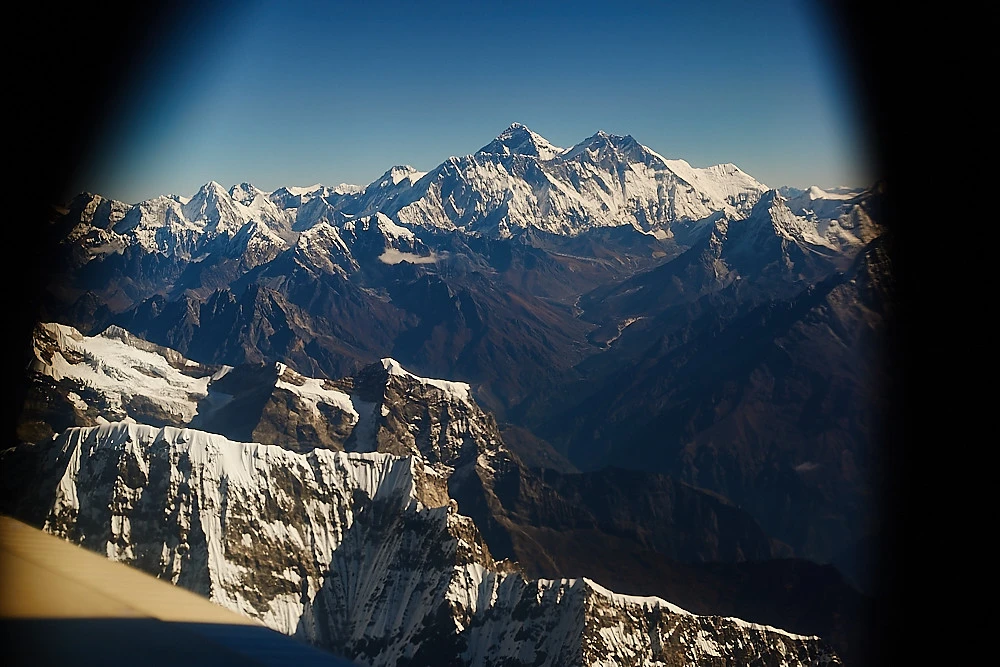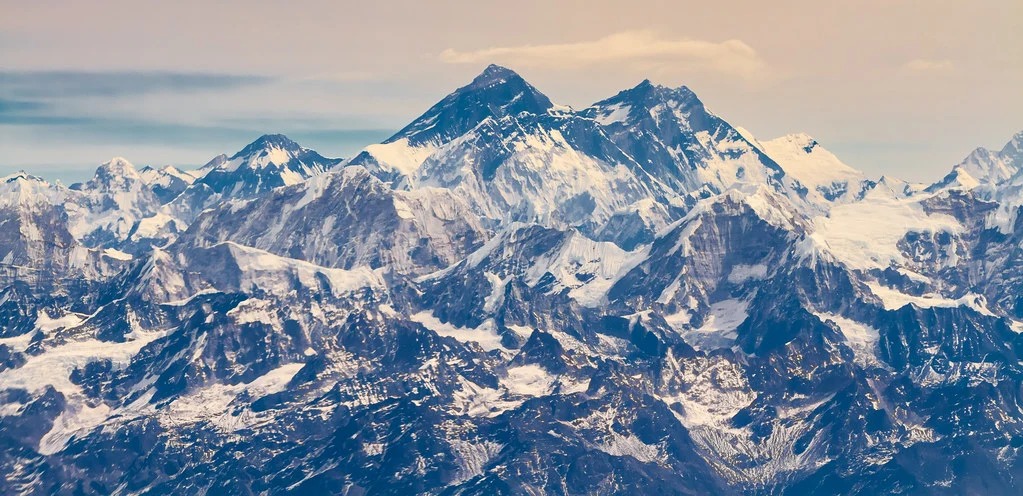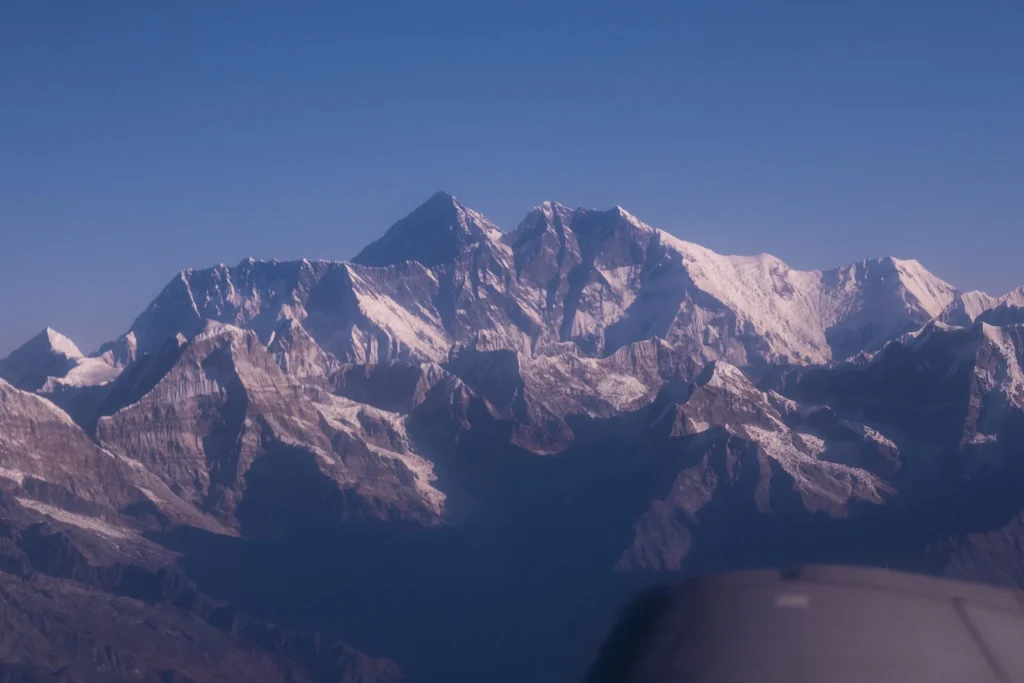Mount Everest Flight from Kathmandu
Sightseeing from Kathmandu above Mount Everest is a thrilling chance to gaze not only at the world’s highest peak but also down on the rest of the Himalayas. Everest flight is also known as a mountain flight or an Everest flyby. These flights are operated by several airlines in Nepal.
The Everest flight from Kathmandu is around 25 min. Passengers can sit back and see the Himalayas and Mount Everest from the airplane windows. Window places are assigned to each passenger in order that he/she can look through the window without obstruction.
The experience has it in fact as an opportunity to come inside the cockpit, with the aim of getting a more complete sight. Everest Flight From Kathmandu are ideal for people who have no physical ability to trek, but are interested to see Mount Everest.


Flights to the Everest area take place over several of the iconic peaks in the Everest foothills (e.g., Lhotse, Makalu, Cho Oyu). Flying is obviously evident in real life, and in the air, the flight crew says, “Peek at mountains. That’s why people get so elated as they hike to the summit: You’ll be learning about every mountain. Air travel is highly safe and is performed by expert pilots.
Can You See Everest from a Kathmandu Flight?
Not exactly, it is also possible to have a look at Mount Everest as part of a daily commercial flight to Kathmandu, but only when the flight path and weather conditions allow it.
Flights to the Everest zone (or from the Everest zone to the final destination in the east) are common in Nepal. The summit of Mount Everest and the other ridges of the Himalayas are clearly visible from the passenger’s window of the plane on a cloudless day.
The incredible thing for the lucky is that one can see Everest from a commercial plane. From the passengers’ point of view, possibly optimal recommendations for seats should be made through a partnership with the airline staff or be available on the flight’s website.
It affects most visitors as a powerful sight when they are looking at the very impressive top of the sky. Whether circuiting around the base camp (a scheduled flight) or sightseeing (a tour flight), observing the peak of Everest from the air is an interesting sight.
From Kathmandu: 1-Hour Panoramic Everest Flight
The panoramic flight to Everest from Kathmandu, the capital city, of the country Nepal is one of the few options available to tourists in Nepal. Everest panaromic flight allows the viewer from the ground to admire from above an incredible panorama from the peak of Mount Everest and other magnificent Himalayan arcs.
All these Everest flights starting very early in the morning days, guarantee the deepest azure skies for sightseeing. Reaching the airport, they take off from a flight following a track close to the summit of Langtang Lirung, Dorje Lakpa, Shishapangma, Gauri Shankar, Makalu, Lhotse and Mount Everest.
Every passenger is seated next to a window and can enjoy the view outside without interruption. Flight attendants are required to describe the morphology of the peaks, which will allow them to identify all of them.

The airplane attendant typically permits the passengers before the cockpit to take a bird’s eye view, as well. Air travel to the Himalayas is available to everybody, e.g., people who are unable to walk and who want to be in the Himalayas.
It is ideal situation for a photographer, an explorer and anybody else who wishes to face the grandeur of Mount Everest without any need to climb onto it. The flight is comfortable and managed in an excellent way; it offers consistent and pleasant views.
Can You See Mount Everest from Kathmandu?
Undoubtedly, under certain conditions of cloud and season, parts of Mount Everest can be seen from some places in the Kathmandu valley, but not always. Mount Everest shimmers under good weather (especially in winter) and can be seen from the rooftops of hill stations.
For example, sites such as Chandragiri Hill, Nagarkot, and rooftop terraces of buildings in the Kathmandu valley provide views of Everest on an extremely large scale.
Among these, Chandragiri Hill is one from which a better view can be taken. It is located at the southwestmost point (16 km) of Kathmandu that can only be accessed by cable car. It shimmers from its high position on top of Everest and smaller hills in the Himalayas on a shimmering day.
The location, 32 km east of the Kathmandu Valley in Nagarkot, is one of the open areas that can be used to admire Mount Everest. It is a hill resort with a view of the Himalayan ranges (e.g., Mount Everest). Flights into Kathmandu provide a stable frame of reference from which to comprehensively monitor the magnificent peak of Everest.
Solitary, on a sight seeing flight, or on these hilltop vantage points, the view of Mount Everest is mystical.
Can You See Everest from Nepal?
Yes, and also from much of Nepal (e.g., most prominently from the Everest range of mountains), Mount Everest is visible. Despite the fact that occasionally, some low shots of Everest can be observed from some high positions, such as Chandragiri Hill or Nagarkot, in Kathmandu, the best view can be observed on the eastern side of Nepal.
Locations such as Namche Bazaar, Tengboche, and Kala Patthar in the Everest area offer breathtaking views of the mountain from a very close distance. Furthermore, visitors can gaze at the summit view by air from the ground over the summit, either by a mountain flight or by a scenic helicopter tour, which shows them the complete Himalayan range with the most recognized peak, the summit.
In addition to trekking routes such as the Everest Base Camp trek, lookout stations are situated throughout Nepal, where one can see Everest. Usual activities are Gokyo Ri, Pikey Peak and Dudh Kunda.
The visibility depends on the weather, there are seasonality and thus the best season to look at Mount Everest is spring (March to May) and autumn (September to November). While the sky is cloudless and the summit is clearly visible on average for a months, Everest under its full glory.
Whether you’re trekking, flying, or visiting a viewpoint, the sight of Mount Everest is always awe-inspiring.
Can You See Everest from Lukla?
No, although it’s true that Mount Everest may (or may not) be seen from Lukla. Yes, it’s possible to see it from Lukla, although at much higher sites and much more conspicuously in the Everest region, its location is not so convenient and easy. Lukla is a landing area for many trekkers who take off at 2,860 m, the altitude above sea level at which the base camp is situated.
Passengers on departure from Lukla might have the chance to watch Everest in the distance on clear days. However, the summit location may be relatively small in scale by itself in view of surrounding hills.
In order to be able to see even better and more comfortably, one has to slightly go up on their way to Namche Bazaar (i.e., altitude). Mount Everest viewing is also made possible by the short flight to Lukla from Kathmandu.
The majority of passengers are fortunate enough to see the summit view from the sky, and, of course, it is on a sunny day when the sky is clear.
Lukla serves as the entrance point for climbers and adventurers seeking to scale Mount Everest. The more spectacular is the scenery from the flight path of Everest and its companions, the closer you fly over the valley of Lukla.
Nepal to Mount Everest Distance
The route between the Kathmandu to Mount Everest is around160 km (99 miles) on the basis of straight line estimate. However, this traveled distance will vary, depending on the mode of transportation, when the individual travels by car or on foot, since when he/she travels by car, there is no direct route from Everest.

Particularly for the trekker the trip never begins except with a flight to Lukla, 138 km (86 mi) south Kathmandu. The Lukla–everest Base Camp is 65 km (40 mi) long and takes from 10-14 days.
In spite of the fact that helicopter flights and mountain flights are the longest (and shortest), respectively, the route to the Everest area does not take more than one hour, and travelling to Solukhumbu (Everest Basecamp) requires a road trip and hiking.
However, the climb offers phenomenal vistas of jade mountains, white snow and empty villages so as to leave them in the memory for a lifetime.
Distance from Kathmandu to Everest Base Camp
The direct line distance between Kathmandu and Everest Base Camp (EBC) is 160 km (99 mi). For most travellers, journey is started by an air flight from Kathmandu to Lukla (138 km/86 mi).
The standard walking distance from Lukla to the EBC is about 65 km (40 mi) and the average estimation of duration for trekking is 8–12 days with a changing program and pace of walking.
Direct Everest Flight From Kathmandu are also available as an option for such individuals, and this is frequently chosen. The goal is to estimate the time interval between patient being lifted from the ground by helicopter and being flown to EBC, targeting the most beautiful place in that direction, the Himalayan range of mountains.
While there’s a lot that you might enjoy walking or hopping, the route from Kathmandu to Everest Base Camp is an experience in itself, which has stunning scenery and a cultural centre.
Kathmandu to Everest Base Camp Helicopter Cost
The cost of helicopter flight from Kathmandu to Everest Base Camp is related to, among other things, the type of package and how many people are flying in one helicopter.
Generally speaking, the price of a shared helicopter tour for two people in flight is about $1,300 and $1,500 per person round trip, and for a private charter, it’s about $5000 and $600 USD and higher.
The cost is nearly as high as a scenic fly/land to Everest Base Camp aerodrome and a (brief) landing at Kalapatthar for the awesome views of Everest and the return flight to Kathmandu aerodrome. Packages which could include the accommodation breakfast of a luxury lodge in the Everest region are also available.
They tend to vary over time of year, season, service type, etc. Spring and autumn are high-price times; temperatures could be slightly high or slightly low and may fluctuate with a slightly upward price trend.
Having gone on that helicopter flight, that is, that “Everest in hand” can be experienced by those who have neither the chance nor, through the chance, the opportunity to climb Everest, but who would like to.
Mount Everest Flight from Kathmandu
Sightseeing flights over Mount Everest from Kathmandu by air, which is also a special opportunity to see the highest mountain in the world and the beautiful Himalaya from the air, and also not be soaked to the skin.
The following airlines (Buddha Air, Yeti Airlines, Shree Airlines, and Simrik Airlines) fly on this area. Flights take off the latest in the morning with the view that the weather is “perfect” and flying is going to be “comfortable” too, respectively.
The journey is about one hour, and in the course of time it is possible to get a beautiful view from scenic peaks like Langtang Lirung, Gauri Shankar, Lhotse, Makalu and, of course, Mount Everest. Every passenger will be entitled to one of the allocated windows places, to see uninterrupted the space in their own view.
Used for these sightseeing flights, such as Beechcraft, ATRs, or their equivalent small aircraft, the aircraft has a capacity of 15–19 passengers.
On board the lift, the crew provide “historical context” and “education for the travelling passenger” with respect to structures of height and their historical significance, as well as educational and inspirational, respectively.
And flight prices are usually in the range of $200 to $250 USD (and may slightly fluctuate depending on the types of airlines or the flight schedule).
Particularly for those on a variable schedule or who feel themselves to be less free to fly near Everest but who nevertheless desire to take in the glory of Everest, a flight on board one of these flights is an option.
Is the Flight from Kathmandu to Lukla Dangerous?
The flight journey from Kathmandu to Lukla is considered one of the most thrilling and dangerous flights in the world, flight route through the difficult topography and the unpredictable nature of its atmospheric conditions in the Everest region.
Lukla’s Tenzing-Hillary Airport (i.e., Lukla Airport), with an altitudinal grade at 2,860 m (9,383 ft), as well as a small runway area due to limited sides up to 527 m, is located on a short runway with steep mountainsides and towering peaks.
However, because of the unique location of the facility and the migratory behaviour of the meteorological phenomena, in some instances, the flight may be extremely hazardous.
Although the flights from Kathmandu in Lukla are on the whole safe, they stand at a greater risk level than other commercial flights. Weather at an area scale can be capricious weather; high winds, fog, and snow make flight difficult, if not impossible.
The Lukla runway is also notorious for its demanding take-off and landing, with a steep incline at one end and a precipice at the other. Pilots are well trained to deal with such situations, and the type of aircraft used at altitude is usually small, like Twin Otters or Dornier 228s, specifically configured for mountain flying.
Although accidents can be severe, accidents are extremely unlikely, and thus, such flights play an indispensable role in trekking in the Everest area. However, all weather must be checked before booking. A number of tourists prefer to fly by helicopter and in some cases walk from Ramechhap to Lukla as an alternative to taking the direct flight from Kathmandu to Lukla.
Is the Everest Flight Tour from Kathmandu Worth It?
The Everest flight tour from Kathmandu is an experience to remember, especially for individuals who desire to observe the impressive peaks of the Himalayas without trekking. Panoramic views from an air cabin view are unique and cannot be experienced by any other view of the sightseeing route.
The flight over Everest and its neighbours delivers a breathtakingly panoramic, experiential perspective of the highest peaks in the Earth, including more lesser-known attractions like Lhotse, Makalu, and Cho Oyu.
One of the key reasons why the Everest flight tour is worth it is the opportunity to experience something extraordinary in just one hour. However, for those with limited time or those who are physically unfit for trekking, this flight provides them with an opportunity to observe the Himalayan landscape up close.
The ease of use of an aeroplane seat, the freedom from having to trek, and the breathtaking views above combine to offer a truly unforgettable experience.
Furthermore, the flight is the perfect introduction to the Everest area. Flight can be preparation for hikers wishing to trek to Everest Base Camp or high-altitude areas, allowing them, both visually and mentally, to get acquainted with the context of trekking the high-land route and understand what they are trekking for.
Send an Enquiry
Error: Contact form not found.
© 2025 - Himalayan Trekking and Tours (P) Ltd. All Rights Reserved.

